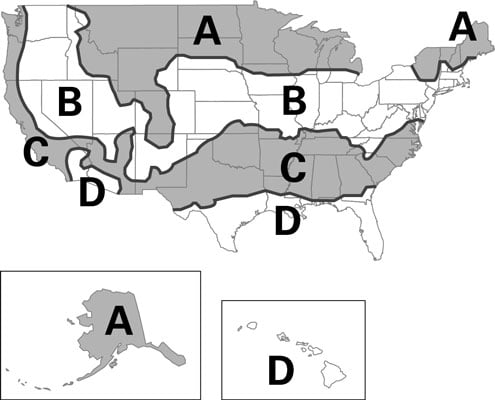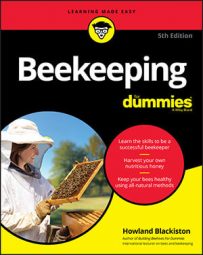Zone A: Short summers and long, cold winters. Average annual temperature is between 35 degrees Fahrenheit and 45 degrees Fahrenheit. Minimum temperatures are between 0 degrees Fahrenheit and 15 degrees Fahrenheit.
Zone B: Summers are hot, and winters can be quite cold and extended. Average annual temperature is between 45 degrees Fahrenheit and 55 degrees Fahrenheit. Minimum temperatures are between 15 degrees Fahrenheit and 20 degrees Fahrenheit.
Zone C: Summers are long and hot, and the winters are mild and short. Average annual temperature is between 55 degrees Fahrenheit and 65 degrees Fahrenheit. Minimum temperatures are between 30 degrees Fahrenheit and 35 degrees Fahrenheit.
Zone D: Warm to hot all year round. Average annual temperature is between 65 degrees Fahrenheit and 80 degrees Fahrenheit. Minimum temperatures are between 30 degrees Fahrenheit and 40 degrees Fahrenheit.

-
Determine your Beekeeping Zone. If you live outside the United States, find the zone on the map with a temperature range that most closely corresponds to your part of the world.
-
Use the table to locate the month of year you are currently in.
-
Look down the “month” column and find your zone letter (A, B, C or D). Wherever your zone letter appears, look at the corresponding activity in the far-left column. This is an activity you should consider doing during this month. All of these activities are covered in more detail within the various chapters of the book.
| Typical Activity | JAN | FEB | MAR | APR | MAY | JUN | JUL | AUG | SEP | OCT | NOV | DEC |
|---|---|---|---|---|---|---|---|---|---|---|---|---|
| Check food reserves | B | B | A,C | A | A | B | B | A,C, D | ||||
| Feed colony if low on capped honey | B, D | B, D | A, B | A, B | A | B | B | B | A, B, C, D | C, D | D | |
| Check for eggs/queen | D | B, C | B, C | A | A | C | D | |||||
| Reverse hive bodies | B | C | A | |||||||||
| Install new bees in hive | B, C, D | A, B | ||||||||||
| First comprehensive inspection of the season | C, D | C, B | B | A | ||||||||
| Check for capped brood and brood pattern | D | B | B, C | A, B, C | A, B | A, B | B | |||||
| Feed a pollen substitute | C, D | A, B, C | A, B, C | |||||||||
| Look for swarm cells | D | B, D | A, B, C, D | A, B, C | ||||||||
| Add queen excluder and honey supers | D | B, D | A, B, C, D | A | ||||||||
| Look for supercedure cells | B, C, D | A, B, C, D | A, B, C, D | |||||||||
| Check ventilation | D | B, C, D | C, D | B | A | A | ||||||
| Add mouse guard | B, C | A, B | ||||||||||
| Medicate for AFB, EFB, and Nosema | D | C | B | A | A, B | C, D | ||||||
| Check surplus honey | D | D | D | A, B, D | A, B, C | A, B | C | |||||
| Harvest honey | D | B, D | B, D | B | ||||||||
| Test for varroa mites | C, D | B | A | D | A, B | A, D | ||||||
| Medicate for varroa mites (if needed) | C, D | B | A | D | A, B | A, C, D | ||||||
| Medicate for tracheal mites | C, D | B | A | A, B | A, C, D | |||||||
| Check hives for small hive beetle. Medicate if needed. | C, D | C, D | ||||||||||
| Prepare hive for winter | A, B | A, B, C | C | |||||||||
| Check entrance for blockage | A, B, C | A, B, C | A | A, B | ||||||||
| Order new bees | A, B, C, D |

